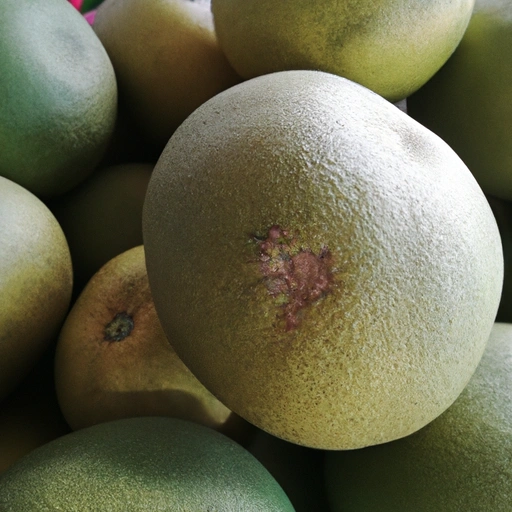Pomelo
Description

The pomelo, also known as 'pummelo,' 'pamplemousse,' or 'shaddock,' is a large, exotic citrus fruit that is closely related to grapefruits. It has a thick, green or yellow peel and a sweet, somewhat milder and less bitter flavor than its cousin. Inside, the fruit is divided into segments that can be easily separated and consumed. Pomelos vary in size, but they typically weigh between 1 and 2 kilograms (2.2 to 4.4 pounds/American) or 1000 to 2000 grams (European), making them the largest citrus fruits available.
Common uses
Commonly, pomelos are eaten fresh – either alone or in fruit salads. They can also be used to add a citrusy zing to desserts, beverages, and savory dishes. In many cultures, the rind of the pomelo is used as well, often candied or used to impart flavor in cooking.
Nutritional value
Calories
A medium pomelo weighing around 600g (21 oz/American) can contain approximately 230 calories.
Protein
Pomelos provide about 5 grams of protein per fruit.
Fat
This fruit is virtually fat-free, with less than 1 gram of fat per fruit.
Carbohydrates
A medium pomelo contains nearly 59 grams of carbohydrates, predominantly from sugars and dietary fiber.
Vitamins
Pomelos are rich in vitamin C, providing a high amount of daily recommended intake in just one serving. They also contain moderate amounts of vitamins A and B-complex.
Minerals
They are a good source of potassium, with one fruit offering up to 10% of the recommended daily intake, along with smaller amounts of magnesium, calcium, and phosphorus.
Health benefits
Pomelos are not only delicious but also boast several health benefits. They are known for their high vitamin C content which supports immune system function and has antioxidant properties. The fiber in pomelos aids in digestion and may help regulate blood sugar levels. Meanwhile, potassium helps maintain cardiovascular health by regulating blood pressure.
Potential risks
While pomelos are generally safe to eat, they can interact with certain medications, much like grapefruits. They contain compounds that may affect the metabolism of certain drugs, potentially leading to side effects. Individuals on medication should consult with a healthcare provider before incorporating pomelo into their diet.
Common recipes
In culinary uses, pomelo can be found in recipes for salads, such as the Thai pomelo salad with shrimp, or desserts like pomelo sorbet. It's also used in marmalades and jams.
Cooking methods
Pomelo is often consumed raw, but it can also be grilled to enhance its flavor or used to infuse flavor into cooked dishes.
Pairing with other ingredients
This fruit pairs beautifully with seafood, coconut, and herbs like mint or cilantro, making it a versatile ingredient for a variety of dishes.
Summary
Pomelo is a versatile and nutritious citrus fruit with a rich history and numerous health benefits. Its unique taste and texture make it a favorite in various culinary creations around the world. Whether eaten raw or as part of a dish, pomelo offers a delightful experience for the palate while contributing to a healthy lifestyle.